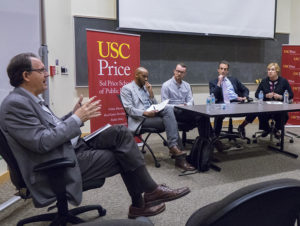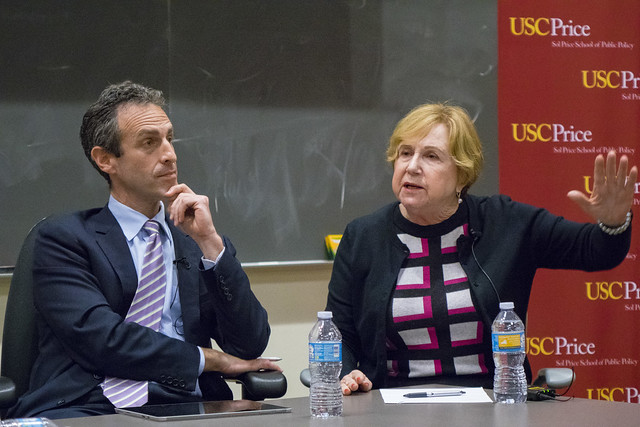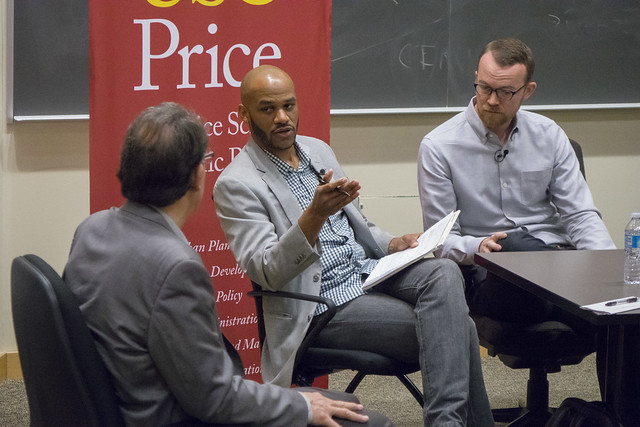Experts debate solutions to LA’s housing crisis during USC Price seminar
To watch the full lecture video, click here »
By Matthew Kredell
Following the defeat of Measure S on the March ballot, the USC Price School of Public Policy’s Urban Growth Seminar, a public lecture series, brought together housing experts to discuss the state of planning in Los Angeles.

Professor Dowell Myers, left, moderates the panel (Photo by Deirdre Flanagan) More photos available on Flickr »
Measure S, which would have put a two-year moratorium on building high-density projects in the city, lost by a 70-30 margin.
Most of the panelists opposed the measure due to the need for housing of any kind. USC Price Professor Dowell Myers, who led the April 4 discussion, estimated that there are 160,000 housing units needed in the City of Los Angeles, which goes up to 350,000 when the entire county is taken into consideration. Having an imbalance of supply and demand leads to affordability issues.
“Right now we’re in the rethinking stage, so it’s a very dramatic moment,” Myers said. “I think it’s safe to say housing is the last sector of the economy to recover from the great recession.”
Addressing the shortfall

Gail Goldberg, right, with Mott Smith (Photo by Deirdre Flanagan)
Professor and Bedrosian Chair Raphael Bostic, who spent three years as Assistant Secretary of the U.S. Department of Housing and Urban Development, contributed a video presentation in which he warned that housing in the city has reached a full-on crisis. He noted that many renters in Los Angeles pay more than 50 percent of their income for housing, and a majority pay more than 30 percent. This is because of a long-run trend in which income for renters has stayed relatively flat since 1990, while rents have increased 25-to-30 percent across the market.
Gail Goldberg, executive director of the Urban Land Institute-Los Angeles and a past planning director for the City of Los Angeles, commented that the city needs a great vision document to give communities a blueprint for how the city should look in 20 years.
Mott Smith, a Dollinger Master of Real Estate Development alumnus who co-founded development and planning firm Civic Enterprise, explained that there is a resistance to development – as evidenced by Measure S – that needs to be overcome. Between 1990 and 2006, the city grew by 500,000 people but just 75,000 housing units.
“We have tried, through all kinds of myths and magic and alchemy, to create housing affordability and inclusiveness,” Smith said. “None of that matters when there are more people in the game of musical chairs than there are chairs.”
Smith added that places such as Silver Lake and Venice have thwarted luxury developments in their area in the name of equity, but that it backfired because people with more money moved there anyway and knocked out lower paying residents.
Shane Phillips, who earned his master’s degrees in urban planning and public administration at USC Price and now works for advocacy group Abundant Housing L.A., contended that the state needs to reform the Ellis Act, which prevents local entities from adding rent-control ordinances.
Preserving local neighborhoods

Damien Goodmon, center, with Shane Phillips (Photo by Deirdre Flanagan)
Damien Goodmon of the Crenshaw Subway Coalition favored Measure S for protecting low-income communities.
“Before we get to discussing where to put new housing, let’s talk about how we’re able to keep our existing communities — which have special character, which are diverse and make Los Angeles the envy of many regions of the world,” Goodmon said. “That conversation forces us to talk about the challenge of gentrification, which is really the special expression of economic inequality.”
As possible solutions to the housing crisis, Bostic suggested the city allow buildings to be developed without parking requirements to lessen construction costs, creating a savings that could be passed on to people who are relying more on public transit, as well as ride-share apps.
Phillips recommended an even greater focus on adding housing units downtown, where direct displacement is more limited and where there’s ability to create the value needed to build more affordable housing. Given the difficulty to make changes at the city level, Goldberg advised that planners can try creative ideas at the neighborhood level through pilot projects.
“This is a city that has not been aspirational — this is a city that worries whatever we do will make things worse,” Goldberg said. “We have to change that with plans about how this can be a better and greater city, and that it continues to be the mosaic of individual diverse communities that make us a very unique and exciting place to live.”